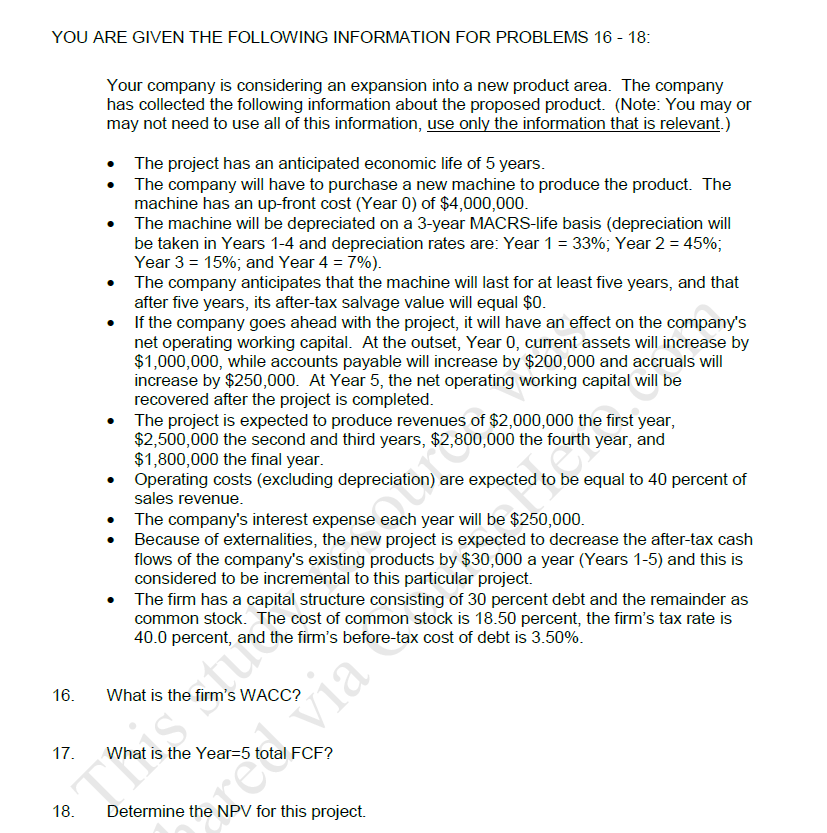
YOU ARE GIVEN THE FOLLOWING INFORMATION FOR PROBLEMS 16 - 18: Your company is considering an expansion into a new product area. The company has collected the following information about the proposed product. (Note: You may or may not need to use all of this information, use only the information that is relevant.) The project has an anticipated economic life of 5 years. The company will have to purchase a new machine to produce the product. The machine has an up-front cost (Year O) of $4,000,000. The machine will be depreciated on a 3-year MACRS-life basis (depreciation will be taken in Years 1-4 and depreciation rates are: Year 1 = 33%; Year 2 = 45%; Year 3 = 15%; and Year 4 = 7%). The company anticipates that the machine will last for at least five years, and that after five years, its after-tax salvage value will equal $0. If the company goes ahead with the project, it will have an effect on the company's net operating working capital. At the outset, Year 0, current assets will increase by $1,000,000, while accounts payable will increase by $200,000 and accruals will increase by $250,000. At Year 5, the net operating working capital will be recovered after the project is completed. The project is expected to produce revenues of $2,000,000 the first year, $2,500,000 the second and third years, $2,800,000 the fourth year, and $1,800,000 the final year. Operating costs (excluding depreciatio are expected to be equal to 40 percent of sales revenue. The company's interest expense each year will be $250,000. Because of externalities, the new project is expected to decrease the after-tax cash flows of the company's existing products by $30,000 a year (Years 1-5) and this is considered to be incremental to this particular project. The firm has a capital structure consisting of 30 percent debt and the remainder as common stock. The cost of common stock is 18.50 percent, the firm's tax rate is 40.0 percent, and the firm's before-tax cost of debt is 3.50%. 16. What is the firm's WACC? 17. lice What is the Year=5 total FCF? 18. Determine the NPV for this project. YOU ARE GIVEN THE FOLLOWING INFORMATION FOR PROBLEMS 16 - 18: Your company is considering an expansion into a new product area. The company has collected the following information about the proposed product. (Note: You may or may not need to use all of this information, use only the information that is relevant.) The project has an anticipated economic life of 5 years. The company will have to purchase a new machine to produce the product. The machine has an up-front cost (Year O) of $4,000,000. The machine will be depreciated on a 3-year MACRS-life basis (depreciation will be taken in Years 1-4 and depreciation rates are: Year 1 = 33%; Year 2 = 45%; Year 3 = 15%; and Year 4 = 7%). The company anticipates that the machine will last for at least five years, and that after five years, its after-tax salvage value will equal $0. If the company goes ahead with the project, it will have an effect on the company's net operating working capital. At the outset, Year 0, current assets will increase by $1,000,000, while accounts payable will increase by $200,000 and accruals will increase by $250,000. At Year 5, the net operating working capital will be recovered after the project is completed. The project is expected to produce revenues of $2,000,000 the first year, $2,500,000 the second and third years, $2,800,000 the fourth year, and $1,800,000 the final year. Operating costs (excluding depreciatio are expected to be equal to 40 percent of sales revenue. The company's interest expense each year will be $250,000. Because of externalities, the new project is expected to decrease the after-tax cash flows of the company's existing products by $30,000 a year (Years 1-5) and this is considered to be incremental to this particular project. The firm has a capital structure consisting of 30 percent debt and the remainder as common stock. The cost of common stock is 18.50 percent, the firm's tax rate is 40.0 percent, and the firm's before-tax cost of debt is 3.50%. 16. What is the firm's WACC? 17. lice What is the Year=5 total FCF? 18. Determine the NPV for this project







